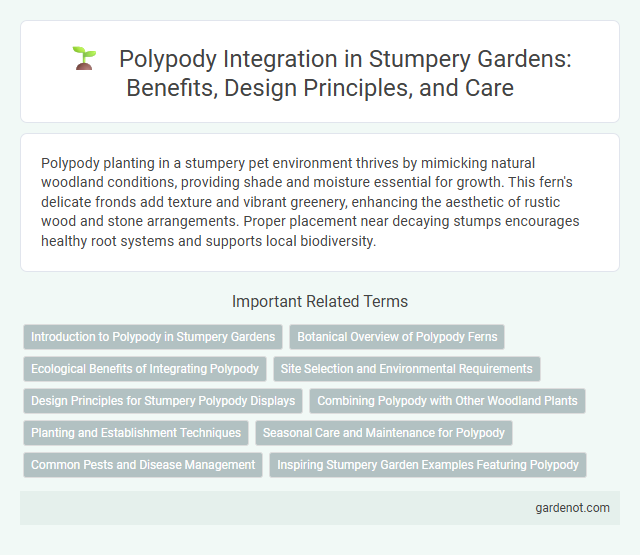Polypody planting in a stumpery pet environment thrives by mimicking natural woodland conditions, providing shade and moisture essential for growth. This fern's delicate fronds add texture and vibrant greenery, enhancing the aesthetic of rustic wood and stone arrangements. Proper placement near decaying stumps encourages healthy root systems and supports local biodiversity.
Introduction to Polypody in Stumpery Gardens
Polypody ferns, known scientifically as Polypodium vulgare, thrive in the shaded, moist environments typical of stumpery gardens, making them an ideal choice for these unique landscapes. Their evergreen fronds provide year-round texture and contrast against decaying wood and moss-covered stumps, enhancing the naturalistic aesthetic of stumperies. Polypody's adaptability to low light and its low-maintenance growth habit contribute to the sustainable design of stumpery gardens.
Botanical Overview of Polypody Ferns
Polypody ferns, belonging to the Polypodiaceae family, are evergreen ferns characterized by their leathery, pinnate fronds and creeping rhizomes, making them ideal for shaded stumpery environments. These ferns thrive in moist, well-drained soils and are commonly found growing on decaying wood or rocky surfaces, facilitating naturalistic planting designs in garden stumperies. Polypody's resilience to shade and drought tolerance enhance biodiversity by providing shelter and microhabitats for various woodland organisms.
Ecological Benefits of Integrating Polypody
Polypody ferns enhance biodiversity by providing habitat and shelter for various insects and small wildlife within stumpery gardens. Their deep root systems improve soil stability and moisture retention, promoting healthier surrounding plant life. Integrating Polypody supports ecological balance by fostering microhabitats and aiding nutrient cycling in woodland environments.
Site Selection and Environmental Requirements
Polypody ferns thrive in shaded, moist environments with well-draining, humus-rich soil that mimics their natural woodland habitat. Choosing a site with partial to full shade protects the fern's delicate fronds from direct sunlight, reducing water loss and stress. Consistent moisture levels and a slightly acidic to neutral pH are critical for Polypody to establish strong roots in a stumpery setting.
Design Principles for Stumpery Polypody Displays
Polypody ferns thrive in shaded, moist environments, making them ideal for stumpery displays that emphasize naturalistic layering and texture contrast. Design principles prioritize grouping Polypody in clusters on decaying wood or stone to mimic woodland floor habitats, enhancing visual depth and ecological authenticity. Integrating varied fern sizes and complementary mosses creates dynamic, multi-dimensional stumperies that support biodiversity and aesthetic appeal.
Combining Polypody with Other Woodland Plants
Polypody ferns thrive when combined with shade-loving woodland plants like hellebores, hostas, and ferns, creating a lush, textured understory in a stumpery. Their evergreen fronds provide year-round interest and contrast beautifully with the bold leaves of hostas and the delicate blooms of hellebores. Polypody's tolerance for dry shade complements moisture-loving companions, enhancing biodiversity and visual appeal in woodland garden settings.
Planting and Establishment Techniques
Polypody ferns thrive in shaded, moist environments with well-drained, humus-rich soil ideal for stumpery installations. Plant rhizomes horizontally just below the soil surface, ensuring consistent moisture while avoiding waterlogging to promote strong root establishment. Mulching with leaf litter or bark chips mimics natural woodland conditions, aiding moisture retention and encouraging healthy growth.
Seasonal Care and Maintenance for Polypody
Polypody ferns require minimal seasonal care, thriving in well-drained, humus-rich soil with consistent moisture during spring and summer growth periods. In autumn, reduce watering to prevent root rot and remove dead fronds to encourage healthy new growth. Winter care involves protecting the plant from frost by applying mulch or relocating potted Polypody to a sheltered environment.
Common Pests and Disease Management
Polypody ferns are susceptible to common pests such as aphids, scale insects, and slugs, which can cause leaf damage and hinder growth. Effective management includes regular inspection, use of insecticidal soap for aphids and scale, and applying organic slug pellets or barriers to control slug populations. Proper cultural practices like ensuring good air circulation and avoiding overwatering reduce the risk of fungal diseases like powdery mildew and root rot in Polypody plantings.
Inspiring Stumpery Garden Examples Featuring Polypody
Stumpery gardens showcasing Polypody ferns highlight the plant's resilience and adaptability in shady, humid environments. Polypody's textured fronds create a visually appealing contrast against decayed timber and moss, enhancing the naturalistic charm of stumpery designs. Iconic examples like the Hillier Stumpery and The Royal Botanic Gardens feature Polypody to achieve lush, woodland-inspired displays.
Polypody planting Infographic

 gardenot.com
gardenot.com